On December 30, 1883, the Ottoman ruler drafted a decree by which he invested the German Emperor William I, his new confederate, into the Golden Order of Merit of his country, called Nishan Imtiyaz. That honor was intended to strengthen the political ties between the German Emperor and the Empire at the Bosporus River.
The insignia of the Golden Order of Merit which Abd al-Hamid awarded to the German Emperor in 1883 yielded 161,000 Euros in the recent auction of Gorny & Mosch 197 (2011)!
Following the order’s statutes the insignia “could be passed on the oldest heir without permission to wear”. Thus when World War II was over William II took the order with him when he went into exile. After the war, it was auctioned off in the Netherlands as part of his estate. In the recent auction, Gorny & Mosch offered that historical testimony as part of the Ede-Uçta Collection for sale: 161,000 Euros – that was the sum the new owner had to pay to acquire the Imtiyaz madalyasi.
Abd al-Hamid visiting England / Balmoral Castle in 1867. Photograph from the George Grantham Bain Collection / Library of Congress. Source: Wikipedia.
To the conservatives of his country, that Abd al-Hamid II who was proclaimed ruler of the Ottoman Empire on August 31, 1876, was more than suspicious. He knew Europe, had toured Austria, France and England, was a skilled carpenter and loved Western operas. He was unconventional and hence the right man for the declining great empire which faced a rather desperate situation. The rich territories of the Balkans were in danger to be lost; in his country the Young Turks cried for political reforms; the treasury was stone-empty.
In addition, Russia took the opportunity to get its share in Turkey, considered as an easy prey. The Russo-Turkish War did not even take a year, but the peace treaty cost the Ottoman Empire dear. It was forced to grant Rumania, Serbia and Montenegro freedom and Bulgaria autonomy. Russia was given Dobruja and parts of Armenia as well as enormous reparations. Although the latter were reduced later in the Congress of Berlin, Abd al-Hamid was forced to convey Cyprus “on lease” to the English for their intercession. In December 1881, his debts forced him to transfer control over the state finances to the Administration de la Dette Publique Ottomane, a British-French consortium which could tighten or loosen the purse strings at will. It comes as no surprise, then, that Abd al-Hamid was in no condition to counter the conquest of Egypt and Sudan in the following year by the British Empire.
The Sublime Porte, therefore, very likely was sick and tired of the Triple Entente – Great Britain, France and Russia – at the beginning of the 1880s. New partners were wanted – and found with the Germans who on their part looked for allies for their new colonial politics. Around 1880, discussions about the Baghdad railway started. It was planned to render the idle territories in Central Anatolia accessible for the Ottomans and open up a way to the Far East for the Germans without the need to use the Suez Canal which was controlled by the British.
Wilhelm I on his desk. Source: Wikipedia.
This is the political background of the conferral of the insignia of the Golden Order of Merit, Nishan-Imtiyaz, by Abd al-Hamid II. On December 30, 1883, the Sultan wrote a personal letter both to the German Emperor William I and his confederate Emperor Francis Joseph of Austria. Both monarchs were given the medals, together with the communication, by the local Turkish ambassador. In Berlin, that was Mehmet Sait (Sadullah) Pasha. He was one of the closest assistants of Abd al-Hamid in those days and was later to pave the way for a democratic Turkey. On February 6, 1884, he reported to his ruler in Istanbul that Emperor William I had worn the decoration in honor of the Ottoman Empire the evening before on the occasion of a festive ball in the imperial palace – that was a huge honor and a diplomatic signal to the Sultan that William approved of his approach.
The diplomatic gift remained in imperial possession even when the grandson of William I, William II, had to leave Berlin after the German defeat in World War I. He took it with him to the Netherlands where he retreated into exile and died in 1941. After the end of the war the medal was auctioned off, together with the estate, and acquired by Dr Kurt-Gerhard Klietmann, a then leading expert on faleristics. He was the one that initiated the academic analysis of the piece. From his possession it got into the hands of Hülya Ede-Uçta who continued the collection of her father, Mehmet Ede.
At Gorny & Mosch’s last sale, this unspectacular bronze medal of 1909 realized 17.250 Euro.
The historically very intriguing Imtiyaz madalyasi was the highlight of the collection. Nonetheless, the other 360 pieces bore testimony of the growing popularity of the collecting field “Turkish medals”, too. As with every new field, there were a lot of surprises. A gilded gnadenpfennig with polished fields in good very fine was estimated at the humble sum of 200 Euros but was sold for 2,500 Euros. An unspectacular suite medal in honor of Mehmet the Conqueror rose from its estimate of 100 Euro to 2,300 Euros. The estimate of an extremely fine and extremely rare tin medal from 1854 on the Three Power Agreement of Turkey, France and England was – and this is an incredible sum to the collector of 19th century medals – 2,500 Euros. That sum, however, was even exceeded by the end result of 9,775 Euros. The bun was taken by a bronze medal from 1909 on the town hall of Istanbul. The extremely fine piece was considered very rare and estimated at 500 Euros but no one would have believed it being sold for nothing less than 17,250 Euros!
The Ede-Uçta Collection proves that it pays off – financially in any case – to open up new collecting fields.











